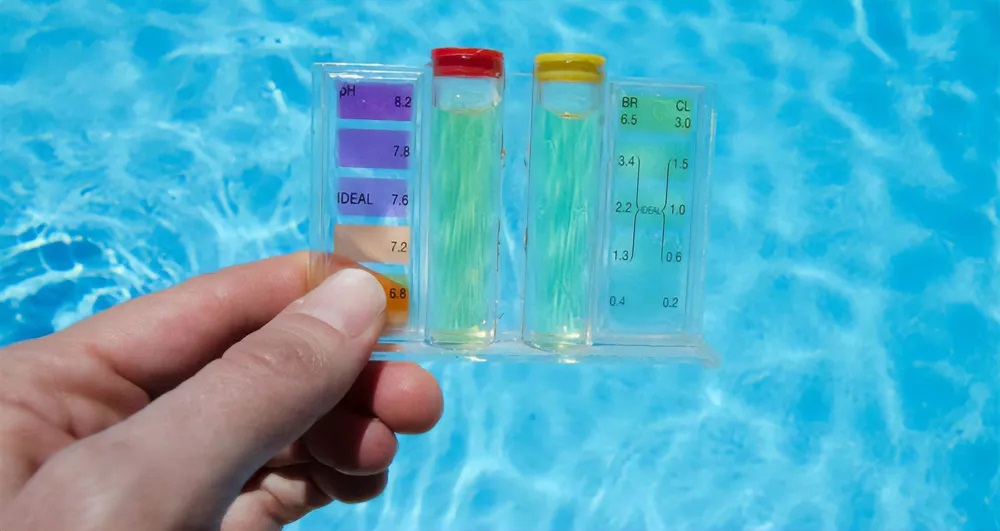To raise the pH level in a pool, you can follow these steps:
- Test the Current how to raise ph in pool: Use a pool water testing kit to measure the current pH level of the pool water. The ideal pH range for a pool is typically between 7.4 and 7.6.
- Add Soda Ash (Sodium Carbonate): Soda ash is commonly used to increase pH levels in pools. Follow the manufacturer’s instructions for the recommended dosage based on your pool size and the current pH level. Generally, for a 10,000-gallon pool, you may need around 1.5 pounds of soda ash to raise the pH by 0.2 units.
- Add Soda Ash to the Pool: Dilute the soda ash in a bucket of water to help it dissolve more easily. Then, pour the mixture slowly around the perimeter of the pool while the pump is running. This will help distribute the soda ash throughout the pool water.
- Allow the Pump to Circulate: Let the pool pump run for several hours to ensure the soda ash is thoroughly mixed and distributed.
- Re-Test the pH Level: After the water has circulated for a while, retest the pH level to see if it has reached the desired range. If needed, you can repeat the process of adding soda ash until the pH is within the recommended range.
- Monitor and Adjust: Regularly test the pH level of your pool water to maintain the appropriate balance. Factors such as rainfall, pool usage, and the addition of chemicals can affect the pH level, so ongoing monitoring is important.
Remember to always follow the manufacturer’s instructions and exercise caution when handling pool chemicals. If you are unsure about the process or need additional guidance, consider consulting a professional pool service or a pool supply store for assistance.
FAQs
Q: Why is it important to maintain the pH level in a pool?
A: Maintaining the pH level in a pool is crucial for several reasons. Firstly, the pH level affects the efficiency of chlorine in disinfecting the water. If the pH is too low (acidic), the chlorine becomes less effective, leading to inadequate sanitization. Secondly, an imbalanced pH can cause skin and eye irritation for swimmers. Lastly, the pH level can impact the longevity of pool equipment and surfaces.
Q: What are the common causes of low pH in a pool?
A: Low pH in a pool can be caused by a variety of factors, including the addition of acidic chemicals (such as muriatic acid or some types of chlorine), heavy rainfall, the use of certain pool algaecides, and high bather load.
Q: Can I use baking soda to raise the pH level in my pool?
A: Baking soda (sodium bicarbonate) can be used to raise the pH level in a pool. It acts as a pH buffer, helping to stabilize the pH and prevent it from fluctuating too rapidly. However, baking soda is more effective at raising the total alkalinity of the pool water rather than the pH directly. If you need to raise both the pH and total alkalinity, using baking soda can be a suitable option.
Q: How long does it take for the pH level to adjust after adding chemicals?
A: The time it takes for the pH level to adjust after adding chemicals can vary depending on factors such as the pool size, water circulation, and the amount of chemicals added. Generally, it is recommended to let the pool pump circulate the water for several hours (4-6 hours) after adding chemicals to ensure proper mixing and distribution. However, it’s important to retest the pH level after some time and make further adjustments if needed.
Q: Are there any natural ways to raise the pH level in a pool?
A: While the most effective and precise way to raise the pH level in a pool is by using pH-increasing chemicals like soda ash or baking soda, there are a few natural methods you can try. For example, aerating the water by running fountains or waterfalls can help increase the pH level over time. Additionally, you can try using crushed limestone or seashells in a mesh bag and placing them in the skimmer basket to slowly release calcium carbonate into the water, which can raise the pH. However, these natural methods may take longer to achieve the desired pH adjustment and might not be as effective as chemical solutions.
Read This: How to Play Tape in Canon 920 Camera
